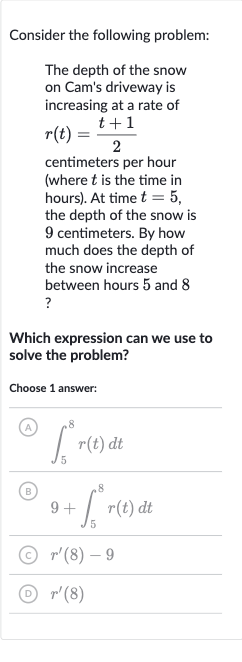AI tutor
Welcome to Bytelearn!
Let’s check out your problem:

Consider the following problem:The depth of the snow on Cam's driveway is increasing at a rate of centimeters per hour (where is the time in hours). At time , the depth of the snow is centimeters. By how much does the depth of the snow increase between hours and ?Which expression can we use to solve the problem?Choose answer:(A) (B) (C) (D)
Full solution
Q. Consider the following problem:The depth of the snow on Cam's driveway is increasing at a rate of centimeters per hour (where is the time in hours). At time , the depth of the snow is centimeters. By how much does the depth of the snow increase between hours and ?Which expression can we use to solve the problem?Choose answer:(A) (B) (C) (D)
- Integrate rate of increase: To find the increase in the depth of the snow between hours and , we need to integrate the rate of increase, , from to . This will give us the total change in depth over that time period.
- Use correct expression: The correct expression to use for this problem is the integral of from to , which is represented by the integral sign with the limits of integration. This corresponds to option (A) .
- Calculate integral of : We will now calculate the integral of from to . The function is given by . The integral of with respect to is the antiderivative of evaluated from to .
- Evaluate antiderivative at : The antiderivative of is . We will evaluate this antiderivative at and and then subtract the value at from the value at to find the total change in depth.
- Evaluate antiderivative at : Evaluating the antiderivative at gives centimeters.
- Find total change in depth: Evaluating the antiderivative at gives centimeters.
- Find total change in depth: Evaluating the antiderivative at gives centimeters.The increase in depth from to is the difference between the antiderivative evaluated at and , which is cm - cm = centimeters.
